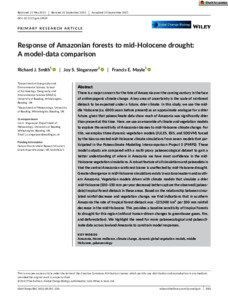Smith, R. J., Singarayer, J. S. and Mayle, F. E.  ORCID: https://orcid.org/0000-0001-9208-0519
(2021)
Response of Amazonian forests to mid-Holocene drought: a model-data comparison.
Global Change Biology, 28 (1).
pp. 201-226.
ISSN 1365-2486
doi: 10.1111/gcb.15929
ORCID: https://orcid.org/0000-0001-9208-0519
(2021)
Response of Amazonian forests to mid-Holocene drought: a model-data comparison.
Global Change Biology, 28 (1).
pp. 201-226.
ISSN 1365-2486
doi: 10.1111/gcb.15929
Abstract/Summary
There is major concern for the fate of Amazonia over the coming century in the face of anthropogenic climate change. A key area of uncertainty is the scale of rainforest die-back to be expected under a future, drier climate. In this study, we use the middle Holocene (ca. 6,000 years before present) as an approximate analogue for a drier future, given that palaeoclimate data show much of Amazonia was significantly drier than present at this time. Here, we use an ensemble of climate and vegetation models to explore the sensitivity of Amazonian biomes to mid-Holocene climate change. For this we employ three dynamic vegetation models (JULES, IBIS, and SDGVM) forced by the bias-corrected mid-Holocene climate simulations from seven models that participated in the Paleoclimate Modelling Intercomparison Project 3 (PMIP3). These model outputs are compared with a multi-proxy palaeoecological dataset to gain a better understanding of where in Amazonia we have most confidence in the mid-Holocene vegetation simulations. A robust feature of all simulations and palaeodata is that the central Amazonian rainforest biome is unaffected by mid-Holocene drought. Greater divergence in mid-Holocene simulations exists in ecotonal eastern and southern Amazonia. Vegetation models driven with climate models that simulate a drier mid Holocene (100-150 mm per year decrease) better capture the observed (palaeodata) tropical forest die-back in these areas. Based on the relationship between simulated rainfall decrease and vegetation change, we find indications that in southern Amazonia the rate of tropical forest die-back was ~125,000 km2 per 100 mm rainfall decrease in the mid Holocene. This provides a baseline sensitivity of tropical forests to drought for this region (without human-driven changes to greenhouse gases, fire, and deforestation). We highlight the need for more palaeoecological and palaeoclimate data across lowland Amazonia to constrain model responses.
Altmetric Badge
| Item Type | Article |
| URI | https://centaur.reading.ac.uk/id/eprint/100586 |
| Identification Number/DOI | 10.1111/gcb.15929 |
| Refereed | Yes |
| Divisions | Science > School of Archaeology, Geography and Environmental Science > Department of Geography and Environmental Science Science > School of Mathematical, Physical and Computational Sciences > Department of Meteorology |
| Publisher | Wiley-Blackwell |
| Download/View statistics | View download statistics for this item |
Downloads
Downloads per month over past year
University Staff: Request a correction | Centaur Editors: Update this record
 Download
Download Download
Download![Open Access [thumbnail of Open Access]](https://centaur.reading.ac.uk/100586/18.hassmallThumbnailVersion/Global%20Change%20Biology%20-%202021%20-%20Smith%20-%20Response%20of%20Amazonian%20forests%20to%20mid%E2%80%90Holocene%20drought%20%20A%20model%E2%80%90data%20comparison.pdf)
